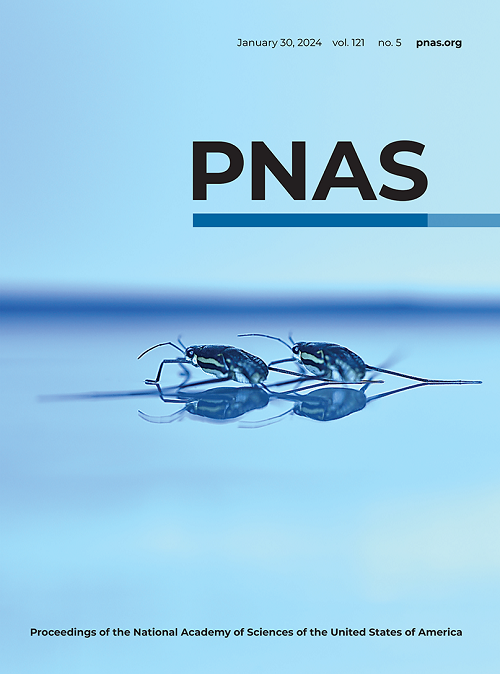Mechanistic insights into the iron-sulfur cluster-dependent interaction of the autophagy receptor NCOA4 with the E3 ligase HERC2.
IF 9.1
1区 综合性期刊
Q1 MULTIDISCIPLINARY SCIENCES
Proceedings of the National Academy of Sciences of the United States of America
Pub Date : 2025-07-24
DOI:10.1073/pnas.2510269122
引用次数: 0
Abstract
NCOA4, a dedicated autophagy receptor for mediating selective autophagy of ferritin (ferritinophagy), plays a vital role in maintaining cellular iron homeostasis. The cellular abundance of NCOA4 is regulated by the E3 ligase HERC2 that can specifically target NCOA4 for proteasomal degradation under iron-replete conditions. However, the detailed molecular mechanism governing the iron-dependent recognition of NCOA4 by HERC2 remains elusive. Here, using multidisciplinary approaches, we systematically characterize the HERC2-binding domain (HBD) of NCOA4 and its interaction with HERC2. We uncover that NCOA4 HBD harbors a [2Fe-2S] cluster and can exist in two different states, the apo-form state and the [2Fe-2S] cluster-bound state. Moreover, we unravel that HERC2 can effectively recognize the [2Fe-2S] cluster-bound NCOA4 HBD through its Cullin-7-PARC-HERC2 (CPH) domain and iron-sulfur cluster-dependent NCOA4-binding domain (INBD) with a synergistic binding mode. The determined crystal structures of HERC2(2540-2700) and its complex with the [2Fe-2S] cluster-bound NCOA4 HBD together with relevant biochemical and cellular results not only elucidate how NCOA4 HBD specifically senses cellular iron level by binding a [2Fe-2S] cluster but also reveal the molecular basis underlying the specific interaction of HERC2 with the [2Fe-2S] cluster-bound NCOA4 HBD. In summary, our findings provide mechanistic insights into the iron-dependent turnover of NCOA4 by HERC2 and expand our understanding of the regulatory mechanism of NCOA4-mediated ferritinophagy.自噬受体NCOA4与E3连接酶HERC2的铁硫簇依赖性相互作用的机制见解。
NCOA4是介导铁蛋白选择性自噬(铁蛋白自噬)的专用自噬受体,在维持细胞铁稳态中起着至关重要的作用。NCOA4的细胞丰度是由E3连接酶HERC2调控的,HERC2可以在铁充满的条件下特异性靶向NCOA4进行蛋白酶体降解。然而,HERC2对NCOA4的铁依赖性识别的详细分子机制仍然难以捉摸。本文采用多学科方法,系统地表征了NCOA4的HERC2结合域(HBD)及其与HERC2的相互作用。我们发现NCOA4 HBD含有一个[2Fe-2S]簇,并且可以以两种不同的状态存在,即载脂蛋白态和[2Fe-2S]簇结合态。此外,我们揭示了HERC2可以通过其Cullin-7-PARC-HERC2 (CPH)结构域和铁硫簇依赖的NCOA4结合域(INBD)以协同结合模式有效识别[2Fe-2S]簇结合的NCOA4 HBD。HERC2(2540-2700)及其与[2Fe-2S]簇结合的NCOA4 HBD复合物的晶体结构以及相关的生化和细胞结果不仅阐明了NCOA4 HBD如何通过与[2Fe-2S]簇结合特异性地感知细胞铁水平,而且揭示了HERC2与[2Fe-2S]簇结合的NCOA4 HBD特异性相互作用的分子基础。总之,我们的研究结果为HERC2对NCOA4的铁依赖性转换提供了机制见解,并扩展了我们对NCOA4介导的铁蛋白自噬调控机制的理解。
本文章由计算机程序翻译,如有差异,请以英文原文为准。
求助全文
约1分钟内获得全文
求助全文
来源期刊
CiteScore
19.00
自引率
0.90%
发文量
3575
审稿时长
2.5 months
期刊介绍:
The Proceedings of the National Academy of Sciences (PNAS), a peer-reviewed journal of the National Academy of Sciences (NAS), serves as an authoritative source for high-impact, original research across the biological, physical, and social sciences. With a global scope, the journal welcomes submissions from researchers worldwide, making it an inclusive platform for advancing scientific knowledge.

 求助内容:
求助内容: 应助结果提醒方式:
应助结果提醒方式:


